
What to include in a cover letter
A well-written cover letter is the key to capturing the attention of employers and encouraging them to read your CV so that you can secure job interviews.
However, it’s tricky to know exactly what to include in a cover letter.
What essential information should you incorporate to impress recruiters?
This article shows you everything you need to include in your cover letter to be successful in your application, plus three cover letter examples.
CV templates
What is a cover letter?
Before we begin, it’s important to know exactly what a cover letter is and why it’s paramount.
Knowing these two things will make it easier to write a standout cover letter that catches the attention of employers.
Your cover letter is a friendly introduction that you send together with your CV to would-be employers and recruiters.
It’s a way to say hi, express your interest in the position, and get them excited about your CV.
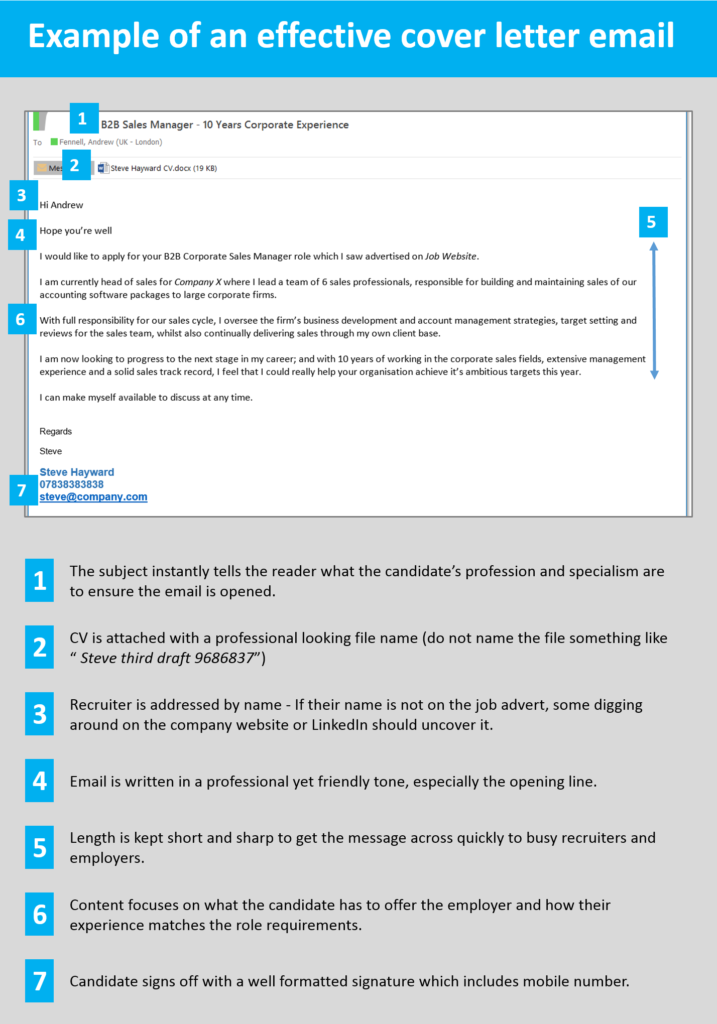
Build your CV now
Your cover letter needs to entice hiring managers and recruiters.
Here’s the essential information that you will need to include in order to do that.
Start by addressing the hiring manager

You will need to begin your cover letter by addressing the person handling the job post to build a rapport with them.
Make sure your greeting is amicable yet professional – don’t make it sound too laidback or unduly formal.
For example, you could address the hiring manager by saying:
- Hi [Insert recruiter’s name]
- Hi [Insert department/team name]
To locate the person’s name, you can sometimes find it on the company’s website by going to the “About” page. Search for names such as the hiring manager, internal recruiter or someone from HR. Then use their name in your cover letter.
Alternatively, you can find their name by quickly searching for the company on LinkedIn. You’ll then see a list of employees and most will have LinkedIn profiles . This is a great way to find the correct name.
Include a friendly greeting
When you’re putting together your cover letter , you will need to include a friendly greeting. This shows that you’re someone who can converse well and connect with others.
However, if your friendly greeting is too casual and overly friendly, it won’t look that professional.
On the flip side, if it’s extremely formal and doesn’t have much personal warmth, you may come across as socially distant.
So, aim to be both professional and approachable. For example, begin with a friendly greeting such as, “I hope you’re doing well.”
And don’t forget – your spelling and grammar need to be spot on in your cover letter. Typos and mistakes won’t impress recruiters.
Specify the job you’re applying for
So, you’ve greeted and warmed up the hiring manager with a friendly opening – great.
Next, you need to get to the point and tell the recruiter which position you’re applying for.
You could say:

Don’t forget – some hiring managers handle numerous job vacancies , so be as precise as you can.
Explain why you’re the best candidate for the position
In the main part of your cover letter describe why you’re suitable for the position in around 3-6 sentences. This is what will encourage the recruiter or hiring manager to explore your CV.
This section gives you a golden opportunity to emphasise what makes you perfect for the position – you must give recruiters a quick overview of your skills , experience, and knowledge.
But, more importantly, connect these skills directly to the requirements of the role you’re applying for.
And don’t be shy – share your achievements to show why you’re the ideal applicant. These are accomplishments and skills you can bring to the company – they prove why you’re a great fit.
Here are some examples of how you can mention your achievements in your cover letter:
- Project manager – “I’ve successfully managed complicated projects, boosting efficiency by 40% and finishing them well before the deadline.”
- Teaching position – “I am passionate about the subject of maths and have been teaching the secondary curriculum for over 10 years. I run the after-school maths sessions, and have acted as head of maths for Bentley Secondary School for the past two years – achieving excellent results for both students and the school alike.”
- Sales position – “In conjunction with my ability to create and deliver long-term sales and marketing strategies in a pressurised environment, I am also multilingual with the ability to speak English, Russian, and Spanish to high standards.”
Conclude and discuss availability
In your final paragraph , say when you’re available for an interview .
For instance, you could say:
“I’m available for an interview at your earliest convenience,” or “I am available for interviewing from 10 th July.”
This communicates your flexibility and enthusiasm and it’s an excellent way to end your cover letter on a high note.
To wrap up your cover letter, include a friendly salutation like “Regards” or “Kind regards”. Not only does this show you’re courteous and have excellent email etiquette, but it also leaves an approachable, positive impression on the recruiter reviewing your application.
End with a formal sign-off
Add a professional signature at the bottom to give recruiters your important contact details.
As well as providing them with various ways to get in touch with you, it also looks extremely professional and demonstrates that you know how to converse in the working environment .
Your professional signature should include:
- Your full name – This helps hiring managers identify who you are.
- Your phone number – Give the contact number employers can reach you on. Ensure it’s working and accurate so that would-be employers can get hold of you during the recruitment process.
- Your email address – Share a professional email address but avoid using excessively casual or unprofessional email addresses like [email protected] or [email protected] .
Optionally, you could include:
- Your professional title – For example, Key Stage 2 Teacher or Account Manager .
- Your professional social network – For example, LinkedIn.

5 tips for writing a successful cover letter
Here are five tips for writing a cover letter that packs a punch.

Keep it succinct
To ensure hiring managers and recruiters actually look at your cover letter, keep it short and concise.
They’re often incredibly busy people, and receive hundreds of cover letters daily, so aim to make yours between 3 and 6 sentences to hold their attention.
Your cover letter’s job is to engage their interest and make them want to review your CV – it serves as an introduction to the potential employer, demonstrating how suitable you are for the role.
But save the more exhaustive details for your CV.
Read the job advert thoroughly
Before creating your cover letter, you must know what the employer is searching for in candidates. Spend some time reading the job advert thoroughly and ascertain the key responsibilities they’re looking for.
Pay particular attention to hard skills such as specific languages, industry experience, and computer programming.
You don’t need to highlight soft skills such as teamwork or problem-solving because these are standard in many jobs and won’t give you much of an edge over other applicants.
When you know what the recruiter is specifically looking for in a successful applicant, you can present these qualities as you write your cover letter.
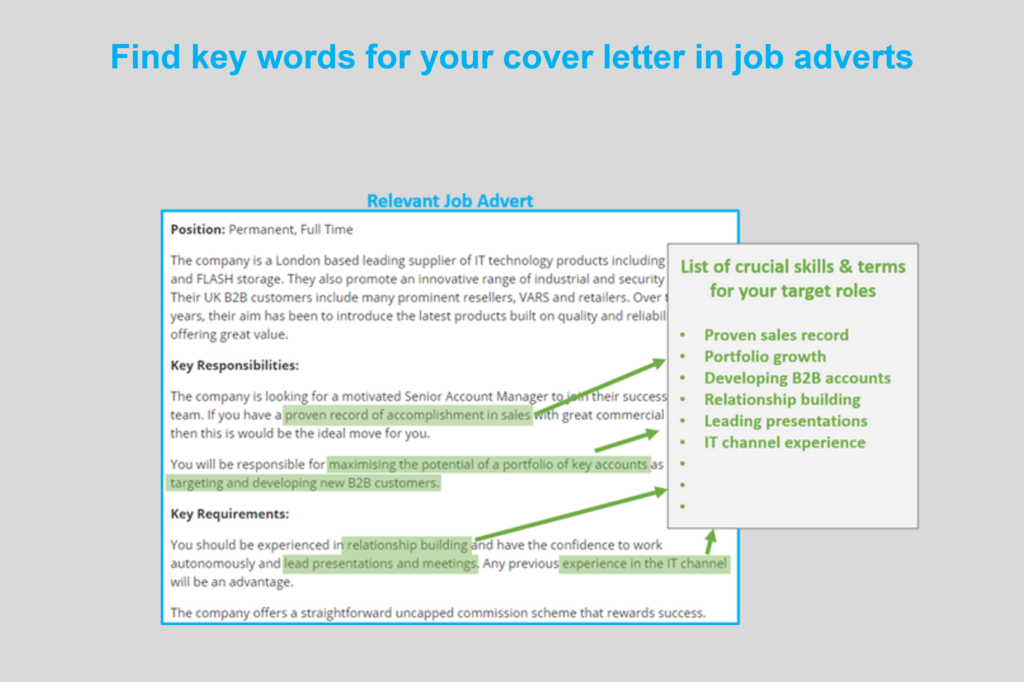
Mention your relevant skills
You want recruiters to notice your CV, right? So show them how your skills and experience match the job requirements.
Begin by carefully scanning the job ad to identify the most significant skills they’re seeking.
Next, describe how your previous experiences have prepared you for these. Be sure to mention any requirements that are absolutely necessary for the job.
Don’t forget – concentrate on what suitable skills you can bring to the table rather than what you want.
For instance, if you’re applying for a marketing role and the job advert specifies you need to be “ excellent at implementing marketing strategie s”, you could say something like:

State why you’re applying
Recruiters will want to know why you’re applying for the job. So always address this in your cover letter.
Your motivation for applying should be positive and signify your dedication to the recruiter or hiring manager.
For instance, say something like, “After working as a Senior Manager for five years at my current company, I’m keen to take on a larger team in a more specialised market.”
Refrain from negative reasons such as, “ My previous company let me go, and I’m looking for a new position immediately .”
Concentrate on your incentive for applying and what you can offer the employer.
Highlight what you’ve accomplished for employers
If you’re an experienced applicant with a lengthy employment history, it’s best to allude to the results you’ve delivered for your existing or previous employers.
For example, mention things like:
- Attracting new clients – Explain how you’ve introduced new business opportunities or expanded the customer base through successful outreach, relationship building or marketing.
- Saving money – State how you have reduced costs, optimised budgets or introduced economic strategies that resulted in savings for the company.
- Enhancing processes – Mention how you simplified operations, boosted workflow, or implemented new ways to boost productivity within the company.
- Making successful sales – Share how you surpassed sales targets, landed noteworthy contracts or always contributed to revenue growth.
In your cover letter, give a snappy overview to keep things succinct. Save the nitty-gritty info for your CV.
3 cover letter samples
To give you some inspiration and ideas for what to include in your cover letter, here are three examples.
Student cover letter example
Students still studying at school or university usually write slightly lengthier cover letters because they may lack work experience. This enables them to concentrate on explaining their education and transferable skills.
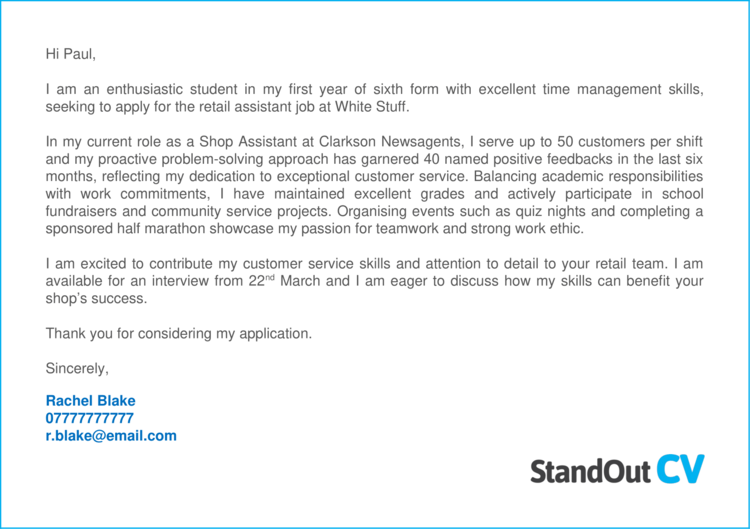
Internal promotion cover letter example
You would use this type of cover letter when you’re already working at an organisation and wish to apply for a new role within the same company.
Here, you can present your qualifications, enthusiasm and achievements to showcase why you’re perfect for the position.
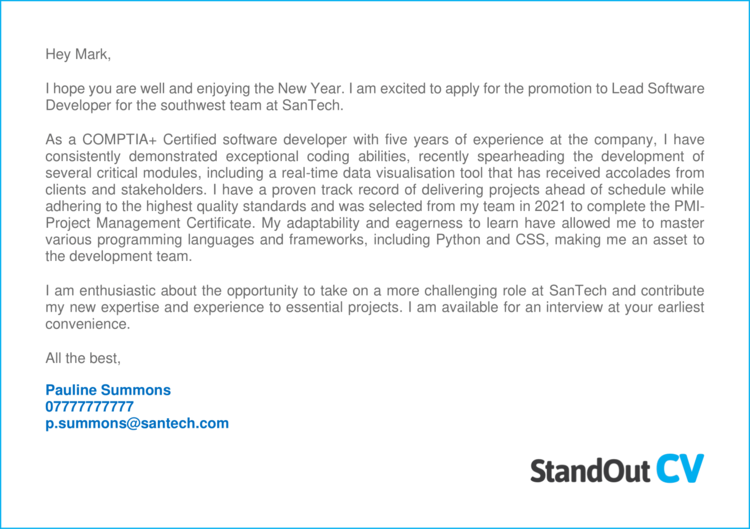
Experienced candidate cover letter example
If you have more employment history to share, this example will help you see how to showcase your skills and experience to stand out in your job application.
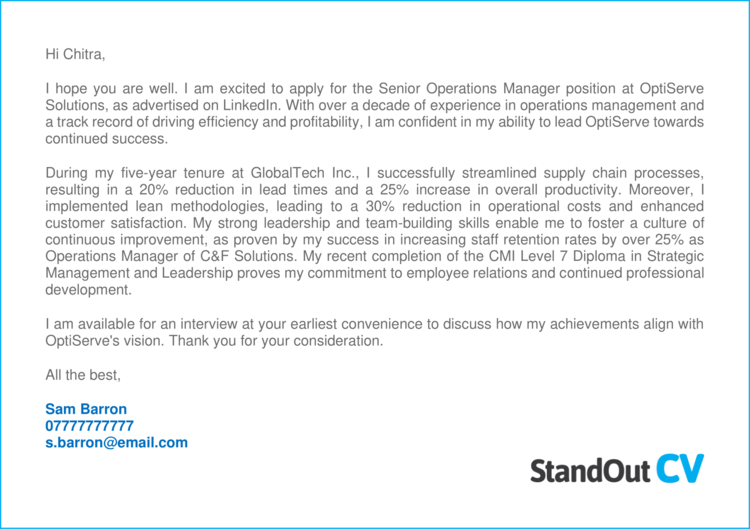
What not to include in a cover letter
Here are five things you should never include in your cover letter:
- Salary expectations – Never mention your salary expectations . It’s best to talk about this later on in the recruitment process.
- Personal info – Avoid sharing your home address, age or marital status. This information isn’t relevant to your job application and may lead to discrimination concerns.
- Embellishments or dishonesties – Never include made-up previous job roles or qualifications that you don’t actually possess. Doing so can put you in an awkward situation.
- Dear Sir or Madam – Start your cover letter with a friendly “Hi” instead, as the former is a dated greeting that lacks a personal touch.
- Typos – Never include grammatical errors in your cover letter as these can hurt your professionalism. Always proofread your cover letter and make sure it’s written, and error-free.
